色温度調整ガラスフィルタ

- Increase the Color Temperature of a Visible Light Source
- Conversion Value: -132 or -160 mireds
FGT05165
Ø12.5 mm
-132 mireds
FGT05200
Ø12.5 mm
-160 mireds
This graph shows the measured transmission curve for a filter with a conversion value (V) of -132 mireds and a filter with a conversion value of -160 mireds.

Please Wait
| General Specifications | |
|---|---|
| Clear Aperture | 80% of Diameter (Circular Filters) |
| Surface Quality | 40-20 Scratch-Dig |
| Transmitted Wavefront Error | < λ/4 at 632.8 nm |
| Dimensional Tolerance | +0.0/-0.4 mm |
| Parallelism | < 3 arcmin |
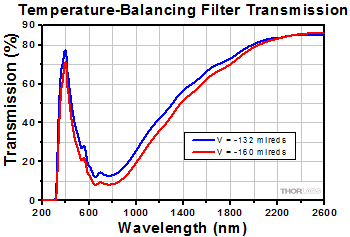
Click to Enlarge
生データのエクセルファイルのダウンロードはこちらをクリックしてください
Figure 1.1 上のグラフは、変換値(V)-132 miredsのフィルタ、ならびに変換値(V)-160 miredsのフィルタの透過率曲線を示しています。 miredsの単位についての詳細は、「変換値」タブをご覧ください。
特長
- 青色の光を透過し、赤色の光を減衰
- Ø12.5 mmをご用意
- 当社のファイバ出力広帯域光源または安定化ファイバ出力光源と一緒に使用
色温度調整ガラスフィルタは、赤色光を減衰し、青色光を透過させることで広帯域光源の色温度を上昇させるように設計されています。 この上昇値は、光源の元々の温度とフィルタの変換値(V)によって決まります。 大きな負の変換値を有するフィルタは、色温度を大きく上昇させます。 当社では変換値が-132 miredsのフィルタ、ならびに-160 miredsのフィルタをご用意しております。 このような変換値を有するフィルタは、イメージング用途において、タングステン光源を自然光に近い色に補正する際に特に便利です。 変換値とmiredsの単位については「変換値」タブをご覧ください。
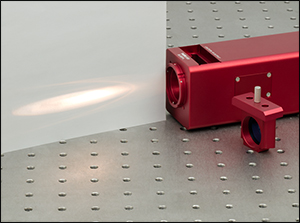
Click to Enlarge
Figure 1.2 この写真は、フィルタ無しの2796 Kタングステンハロゲン光源SLS201L(/M)からの出力光です。フィルタがある場合と無い場合の出力を示したグラフは「変換値」タブをご覧ください。
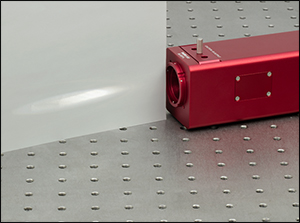
Click to Enlarge
Figure 1.3 この写真は、Ø25.0 mmフィルタFGT200(旧製品)を取り付けた2796 Kタングステンハロゲン光源SLS201L(/M)とその出力光です。フィルタがある場合と無い場合の出力を示したグラフは「変換値」タブをご覧ください。
| Table 2.1 Color Temperature of Light Sources After Filter | |||
|---|---|---|---|
| Light Source Item # (Unfiltered Temperature) | |||
| Conversion Value | SLS201L (2796 K) | OSL2 (3200 K) | |
| -132 mireds | 4432 K | 5540 K | |
| -160 mireds | 5059 K | 6557 K | |
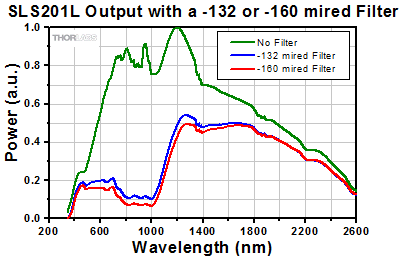
Click to Enlarge
エクセルファイルの生データをダウンロードはこちらから
Figure 2.2 グラフでは、-132 miredのフィルタまたは-160 miredのフィルタを取り付けた場合と取り外した場合の光源 SLS201L/(M)のスペクトルを示しています。
光源の色温度はmireds(micro reciprocal degrees:逆色温度)で示され、ケルビン温度の逆数を106倍して求められます。 例えば、安定化ファイバ出力光源 SLS201L/(M)の色温度は2796 Kで、これは358 miredsとなります。 miredsのSI単位は、メガケルビンの逆数(MK-1)になります。
このページでご紹介しているフィルタは負の変換値を有しているので、光のmireds表示の色温度を低下させますが、ケルビン表示の色温度は上昇します。 フィルタを取り付けた光源の色温度は以下の計算式で求められます。ここでVはフィルタの変換値miredsを示し、K1はフィルタ取付前、K2はフィルタ取付後の光源の色温度をそれぞれケルビンで示しています。

Table 2.1には、当社の白色光源にフィルタを取り付けた時の色温度の計算値が表示されています。例えば、-132 miredsの変換値を有するフィルタを用いた場合の光源 SLS201L/(M)の色温度を求めるには、まず、上記の式を変換してK2を次のように求めます: K2 = (106) / (V + 106/K1)。次に、初めの色温度(K1 = 2796 K)と変換値(V = -132 mireds)を代入すると、K2 = 106 / 226 = 4432 Kが得られます。 Figure 2.2では、-132または-162 miredのフィルタを取り付けた場合と取り外した場合の光源SLS201L(/M)の出力値を曲線で示しています。
| Posted Comments: | |
Sebastian de Echaniz
(posted 2024-11-05 12:05:48.153) Can you please confirm if these are indeed HOYA LB200 with 2.0 mm thickness? HOYA published transmission (https://www.hoyacandeo.co.jp/english/products/eo_pdf/LB200.pdf) is larger below 400 nm than your published spectrum. EGies
(posted 2024-11-14 12:39:05.0) Thank you for contacting Thorlabs. The FGT200 does use Hoya LB-200 glass. Our published transmission data is based on an in-house measurement of a singular melt. I have reached out to you directly regarding this. tomerg
(posted 2014-08-05 09:15:34.103) I have a Thorlabs hologen lamp OSL2 and I want to use the FGT200M color balancing filter with it (put in front of the source).
Is it Ok from themral point of view (i.e. deformation, breaking, etc.)?
Thanks, Tomer. jlow
(posted 2014-08-08 08:35:53.0) Response from Jeremy at Thorlabs: We have not tested this with the OSL2 but this should be fine if you mount it in a metal holder and use the full aperture of the optic. |
 Products Home
Products Home














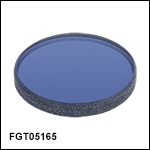
 ズーム
ズーム
 色温度調整ガラスフィルタ
色温度調整ガラスフィルタ